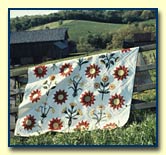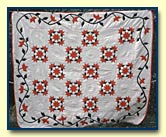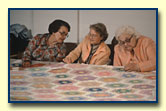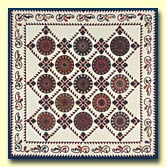
1994 1st Place National Winner; Sunflowers
Lands' End All-American Quilt Contest Collection

Eight-pointed star quilt
Blue Ridge Parkway Folklife Project Collection, 1978
The Online Collection
The Blue Ridge Parkway Folklife Project Collection
The Lands' End All-American Quilt Contest Collection

1994 1st Place National Winner; Sunflowers Lands' End All-American Quilt Contest Collection |

Eight-pointed star quilt Blue Ridge Parkway Folklife Project Collection, 1978 |
Quilts and Quiltmaking in America presents 181 segments from recorded interviews with quiltmakers and 410 graphic images (prints, positive transparencies, and negatives) from two collections in the American Folklife Center at the Library of Congress: the Blue Ridge Parkway Folklife Project and the Lands' End All-American Quilt Contest Collection. The images of the quilts convey the range of contemporary quiltmaking styles in the United States, while the recorded interview segments provide information on the quiltmakers and their work within the context of their lives and region and a more in-depth portrait of quiltmaking in daily life.
There are many ways to study quiltmaking, but one of the most rewarding is to look at the kinds of quilts that were made in a particular time and place. To understand the local picture, however, a researcher needs to know how the local traditions compare with national trends or with local traditions elsewhere.
The quilt-related information in the Blue Ridge Parkway Folklife Project is significant because it represents in-depth interviews with a number of quiltmakers within a limited geographic area during the late-twentieth-century quiltmaking revival. Photographs and brief interview segments were chosen from the collection by the project's consultant, Laurel Horton, based upon the way they work together to interpret the story of quiltmaking in the Blue Ridge. She selected six individuals who represent a cross-section of the quiltmakers in the region at the time of the project (1978) and selected photographs and narratives of both historic and newly made quilts. Because the interview subjects present a range of backgrounds, motivations, and aesthetic sensibilities, their interviews reveal the difficulty of defining a single "Appalachian" quiltmaking tradition. The quilts selected represent a range of functional types, including utility bedquilts, elaborate special quilts, and those made to sell at craft shops and flea markets. As a result, the interviews and visual images demonstrate both continuing local traditions and the influence of the national quilt revival.
In the years since it was created, the Blue Ridge collection has become an important source of historical information. All audio data on this site has been transcribed by the project's consultant, Laurel Horton, in order to enhance its value to researchers who may be hearing-impaired, may be unfamiliar with the dialect of the subject or interviewer or with spoken English, or who need clarification on quilt-related vocabulary or local place names.
The Lands' End collection provides a different but complementary window into late-twentieth century quiltmaking. This online presentation documents the 181 state and national winners of contests sponsored by the company in 1992, 1994, and 1996, and reflects a sampling of excellent design and technical skill characteristic of prizewinning quilts during this period. This collection is important because it represents a large number of quilt images from all across the country and because it includes statements provided by the makers in surveys about their quilts. The Lands' End contest winners represent a wide range of quiltmaking activity, from highly traditional to innovative.
Information about the complete collections in the Archive of Folk Culture follows:
The Blue Ridge Parkway Folklife Project Collection

Leota McAlexander, Vera Stanley, Ruth Spangler on side of quilt frame Blue Ridge Parkway Folklife Project Collection, 1978 |
The Blue Ridge Parkway Folklife Project Collection contains the audio recordings, video recordings, photographs, publications, ephemera, and accompanying manuscript materials associated with the American Folklife Center's 1978 field study of folklife in and around a seventy-mile stretch of the Blue Ridge Parkway at the Virginia and North Carolina border. The study covered parts of Grayson, Carroll, Floyd, and Patrick Counties in Virginia, and Alleghany, Wilkes, and Surry Counties in North Carolina. The Center undertook the project in cooperation with the National Park Service. It was designed to document the region's folklife and to benefit its sponsors and the general public, including citizens who live near the Parkway and visitors who travel along it.
The project spanned the years 1978 to 1981 and involved three phases: pre-fieldwork, fieldwork, and post-fieldwork. The pre-fieldwork phase occurred between February and August 1978 and involved identifying the section of the Parkway to be studied, choosing field team members, and preparing a background research document. The fieldwork took place chiefly during August and September 1978 and was conducted by ten folklorists and photographers who interviewed residents of the area and documented a range of traditional cultural expression, oral, material, and behavioral. Charles Wolfe and Carl Fleischhauer were field coordinators. The fieldwork included an intern program designed to train selected Park Service employees in folklife study.
Although each team member was a specialist in some area of folklife or folklore, all acted as generalists except Margaret Owen, who focused on dance traditions. The subjects best represented in the materials they collected are quiltmaking, religious services and music, folk narrative, folk architecture, foodways, tobacco culture, secular music, folk dance, and fox hunting.
The post-fieldwork phase lasted through 1981 and involved preparing the project's final products. A final report, The Process of Field Research, which summarized the projects's findings and recommendations, was presented to the National Park Service. Two publications were produced: the book Blue Ridge Harvest, edited by Terry Eiler, Lyntha Scott Eiler, and Carl Fleischhauer; and the two-LP album set Children of the Heav'nly King, edited by Charles Wolfe. In addition, several fieldworkers wrote essays on particular topics of their research. The collection was arranged and housed in the Archive of Folk Culture in the American Folklife Center at the Library of Congress, and a large body of duplicate materials was presented to the National Park Service for use as a reference archive in designing and and improving interpretive programs.
For more information, consult the Blue Ridge Parkway Folklife Project Collection guide.
The Lands' End All-American Quilt Contest Collection

1996 1st Place National Winner; Sunset Over Rainbow Bridge Lands' End All-American Quilt Contest Collection |
The Lands' End All-American Quilt Contest Collection consists of quilt photographs, essays by quiltmakers, entry forms, and administrative materials from quilt contests sponsored in 1992, 1994, and 1996 by Coming Home, the linens and home-decorating division of Lands' End, Inc., a catalog and home shopping service, and Good Housekeeping magazine. The collection was donated to the American Folklife Center by Lands' End in 1997.
The rules for the contests specified that quilts must represent an original design or an original interpretation of a traditional pattern and that no quilts made from kits would be considered. Quilts made by groups or by children were also eligible. Contestants were asked to submit a color photo or slide of their quilt. A few quilters also enclosed fabric samples. "If Quilts Could Talk" was the theme for 1994 and 1996, and a one hundred-word essay on the theme was required of finalists in 1994 and of all entrants in 1996.
There were approximately 13,100 entries for the three contests. The collection contains 61.5 linear feet of material, including approximately 18,843 visual images and 60,716 manuscripts. Numerous types and styles of needlework, quilting, piecework, applique, and embroidery are represented among the visual images.
Prizes of $10,000, $3,000, and $2,000 were awarded to the national first-, second-, and third place winners. A winner was also named from each state and the District of Columbia, and those were announced and their quilts' photographs published in Good Housekeeping magazine and in Coming Home, the catalog. The 1996 first-place national quilt, made by Candy Goff of Montana, was displayed in 1996 at the reception to celebrate the twentieth anniversary of the American Folklife Center at the Library of Congress.
For more information, consult the Lands' End All-American Quilt Contest Collection
guide.